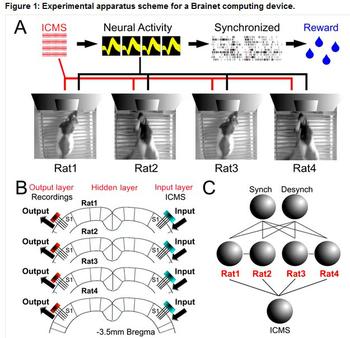Researchers at Duke University previously proposed the idea of 'Brainets'. These are brain networks which are formed by multiple animal brains exchanging information in real-time via brain-to-brain interfaces (BtBI). Such Brainets plus brain-machine interfaces (BMI) could be used to create a new type of computer – an organic computer, theorised the researchers.
Quad core
Just ahead of the weekend the researchers published a follow-up to their earlier research. They describe an experimental demonstration of an organic computer, constructed from four adult rat brains, in the journal Nature.
ICMS = intracortical electrical microstimulation
The researchers had a hypothesis that the Brainnet could outperform individuals brains via the BtBI's distributed and parallel computing architecture. The Brainet rats were said to "consistently outperformed individual rats," in all tasks set. It was observed that the Brainet performance improved over time.
Tests taken out using the rat Brainet include computational problems covering tasks like; discrete classification, image processing, storage and retrieval of tactile information, and even weather forecasting.
Rain prediction with 41 per cent accuracy
The weather forecasting Brainet example is particularly interesting. The researchers used a three rat Brainet for this test. One of the rats received temperature change data, barometric data was sent to the other two rats' brains. "Overall, our 3-rat Brainet predicted changes in the probability of precipitation with 41.02 ± 5.1% accuracy which was much higher than chance," observed the Duke University team. For Brainet to work at its best efficiency the rats had to be awake and be expecting reward for their correct behaviour.
In conclusion the scientists say that their results "provide a proof of concept for the possibility of creating computational engines composed of multiple interconnected animal brains," and that they could be used in testing building organic computing devices that can take advantage of a hybrid digital-analogue architecture. So, one day, computers might come with organic brain co-processing options.
While the rats in the experiments are connected with invasive microwire arrays fixed to the somatosensory cortices of the brain, non-invasive human Brainets and BMIs are being researched with the hope that a brain-controlled exoskeleton could help sufferers of paralysis, for example.








